
 Classics in September -– George Harmon Coxe is largely forgotten now, though his career is emblematic of the development of American crime fiction. Coxe began writing crime fiction for pulp magazines in the Great Depression, one of a raft of writers churning out popular entertainment for a penny per word. We remember some of these pulp scribes today: Hammett, Chandler, Thompson. Even lesser lights are still luminous: Horace McCoy or John D MacDonald. Others, like Carroll John Thompson and Donald Henderson Clarke are long forgotten, and with some justification.
Classics in September -– George Harmon Coxe is largely forgotten now, though his career is emblematic of the development of American crime fiction. Coxe began writing crime fiction for pulp magazines in the Great Depression, one of a raft of writers churning out popular entertainment for a penny per word. We remember some of these pulp scribes today: Hammett, Chandler, Thompson. Even lesser lights are still luminous: Horace McCoy or John D MacDonald. Others, like Carroll John Thompson and Donald Henderson Clarke are long forgotten, and with some justification.
Coxe does not quite fit into any of these categories. Certainly not the literary equal of Hammett or Chandler, he nonetheless was an adept hardboiled writer. Tellingly, several of his Flashgun Casey novels were originally published by AA Knopf. But today, Coxe is neither hailed as classic nor dismissed as schlock. It does not seem that many people think about Coxe anymore.
Mysterious Press is rectifying this omission by rereleasing a great many of George Harmon Coxe’s novels as ebooks. Jack ‘Flashgun’ Casey is Coxe’s most famous protagonist, and several Flash Casey novels are newly available from mysterious press. Casey is a Boston crime photographer, but his burly and implacable persona is as hardboiled as any private eye that ever came out of the same pulp magazines.
Deadly Image was the author’s fifth and final Flash Casey novel. (Sam Durell author Edward S Aarons wrote one Casey novel under the pseudonym Paul Ayres.) Published in 1964, Deadly Image came long after Black Mask and similar publications had become obsolete. Nonetheless, Deadly Image loses none of the punchy, bare-knuckled charm that brought Coxe to pulp glory.
Like any good hardboiled hero, Flash Casey is adept at helping blackmail victims. When a friend is slipped a mickey and then photographed next to a scantily-clad blonde, extortion inevitably follows. Casey tries to find out who made a patsy of his friend, but blackmail is always just the beginning of a good hardboiled story. Murders follow in short order, and Casey must sort through murky characters and upright people who aren’t what they seem.
Flash Casey is assisted by private detective Sam Delemater, and Lieutenant Logan of the Boston police provides a foil – but Casey does most of the detection on his own. Though adroit at solving crimes, Flashgun also lives up to his nickname, as taking and developing photographs yields crucial information at several junctures throughout the plot. Like most hardboiled heroes, Casey figures out most of the case through inspiration rather than ratiocination. Nonetheless, the climax of the mystery yields a surprise that you will likely not see coming – even our hero didn’t.
George Harmon Coxe does not quite belong next to Raymond Chandler. Their copy may have been juxtaposed in pulp magazines, and their books may have been shelved in close proximity half a century ago. Coxe is not quite timeless, but he is still worth modern readers’ time. He didn’t change the genre in which he wrote; he is emblematic of it. But he is an excellent example of solid hardboiled writing, with all the deceitful dames and brisk-talking tough guys that we love to read.
Mysterious Press and Open Road Media are doing a valuable service by reviving Coxe’s work as ebooks. Other Flash Casey ebooks are available, as well as novels featuring Coxe’s other Boston crime photographer, the more urbane Kent Murdock. Unique among hardboiled heroes, Murdock was married. Whether the protagonist is Casey, Murdock, or another character (the writer had several series characters, in addition to penning numerous stand-alone novels), George Harmon Coxe offers both nostalgia and a look at entertainment in an era that no longer exists.
Find more about George Harmon Coxe’s books here.









Well done and well written. Thanks for the article. I read some of his books a while back. It’s certainly good to see he’s back in print.
Ed Lynskey